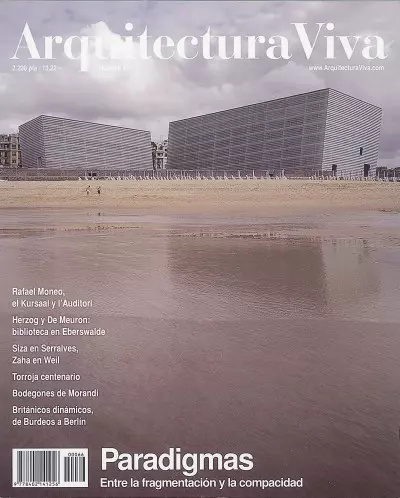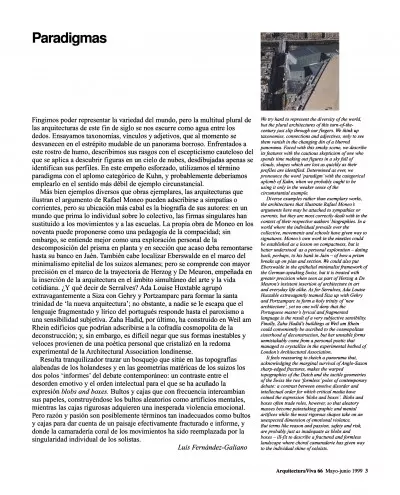Synopses
Architectural Paradigms. Aspiring to reflect the spirit of the times, contemporary architecture defines itself as something broken, fractured and discontinuous or, at the other extreme, as something formless, unstable and fluid; but form itself is absent from the debates of the discipline. With this as a point of departure, having analyzed the antecedents which converge in these dominant tendencies, Rafael Moneo proposes a third way – neither fragmented nor simply topographical – characterized by compactness.
Contents
Rafael Moneo
Architectural Paradigms
Fragmentation
Formlessness
Compactness
Luis Fernández-Galiano
K for Kursaal
Moneo in San Sebastián
Buildings: Projects and Realizations
Compactness and Transparency. Moneo in Barcelona and Herzog & De Meuron in Eberswalde use prismatic forms to pursue opposite objectives: the strict modulation of the auditorium allows the Spaniard to unify the program while delivering an urban statement; and the singular printed facade of the library permits the Swiss to achieve their aim of ‘destroying the box’. Architecture
Carlos Martí
Urban Acustics
Moneo in Barcelona
Gerhard Mack
The World in its own Image
H&dM in EberswaldeThe Poetics of the Fragment. With the dissolution and fracturing of limits, architecture enters into a dialogue with landscape. In Porto, Siza allows the garden of the Serralves Foundation to penetrate the exhibition spaces of the new museum; and in Weil am Rhein, Hadid reflects the frontier condition of the site with a pavilion conceived as a meeting point of different paths.
Juan Miguel Hernández León
The Pleasures of Memory
Siza in Porto
Hubertus Adam
Crossroads
Zaha Hadid in Weil am Rhein
Books, Exhibitions, Personalities
Creation and Pedagogy. Eduardo Torroja, whose centenary is being celebrated, represents the creative side of Spanish Modernism; and Josep Maria Sostres, whose work is being shown, its most pedagogical face. Art / Culture
Javier García-G. Mosteiro
Torroja: a Centenary
Jorge Torres
Lessons from SostresTheater of Objects. The Thyssen Museum vindicates the silent, metaphysical paintings of landscapes and still-lifes by Giorgio Morandi; and the Reina Sofïa reveals the pioneering nature of the sculptures of Ángel Ferrant. Guillermo Solana
Morandi in the Thyssen
Javier Maderuelo
Ferrant in the Reina SofíaInternational Style. The translation of the avant-garde creed by different cultures and contexts led to such singularly creative episodes as the Scandinavian Modernism of Aalto, or the Californian version represented by Neutra. Historietas de Focho
Vladimir Tatlin
Various Authors
Books
Interiors, Design, Construction
British Figuration. The reinterpretation of contextual and programmatic elements have given rise to the ‘barrels’ by Richard Rogers, which extend the Law Courts in Bordeaux; to the iridescent ‘amoebas’ by Sauerbruch & Hutton, that house an optics laboratory in Berlin; to the aluminium ‘kettles’ by Branson & Coates in Sheffield, that are an interactive theater for the National Centre for Popular Music; and the nautical ‘periscope’ by Future Systems, that houses the media centre for the Lord’s cricket ground in London. Technique / Style
Richard Rogers
Law Courts, Bordeaux
Sauerbruch & Hutton
Photonikzentrum, Berlin
Branson & Coates
Centre for Pop, Sheffield
Future Systems
Media Centre, LondonTo close, Ignacio Paricio presents a critical balance of the role of high-tech in the evolution of construction; y Luis Fernández-Galiano reflects on the contemporary habitat following the thread of a current exhibition at the MoMA. Ignacio Paricio
High Construction
Luis Fernández-Galiano
Much-Talked-about Houses
Luis Fernández-Galiano
Paradigms
We try hard to represent the diversity of the world, but the plural architectures of this turn-of-the-century just slip through our fingers. We think up taxonomies, connections and adjectives, only to see them vanish in the changing din of a blurred panorama. Faced with this smoky scene, we describe its features with the cautious skepticism of one who spends time making out figures in a sky full of clouds, shapes which are lost as quickly as their profiles are identified. Determined as ever, we pronounce the word ‘paradigm’ with the categorical aplomb of Kuhn, when we probably ought to be using it only in the weaker sense of the circumstantial example.
Diverse examples rather than exemplary works, the architectures that illustrate Rafael Moneo’s arguments here may be attached to sympathies or currents, but they are most correctly dealt with in the context of their respective authors’ biographies. In a world where the individual prevails over the collective, movements and schools have given way to signatures. Moneo’s own work in the nineties could be established as a lesson on compactness, but is better understood as a personal exploration – dating back, perhaps, to his bank in Jaén – of how a prism breaks up on plan and section. We could also put Eberswalde in the epithelial minimalist framework of the German-speaking Swiss, but it is treated with greater precision when seen as part of Herzog & De Meuron’s insistent insertion of architecture in art and everyday life alike. As for Serralves, Ada Louise Huxtable extravagantly teamed Siza up with Gehry and Portzamparc to form a holy trinity of ‘new architecture’, yet no one will deny that the Portuguese master’s lyrical and fragmented language is the result of a very subjective sensibility. Finally, Zaha Hadid’s buildings at Weil am Rhein could conveniently be ascribed to the cosmopolitan sisterhood of deconstruction, but her unstable forms unmistakably come from a personal poetic that managed to crystallize in the experimental hotbed of London’s Architectural Association.
It feels reassuring to sketch a panorama that, acknowledging the marginal survival of Anglo-Saxon sharp-edged fractures, makes the warped topographies of the Dutch and the tactile geometries of the Swiss the two ‘formless’ poles of contemporary debate: a contrast between emotive disorder and intellectual order for which critical media have coined the expression ‘blobs and boxes’. Blobs and boxes often trade roles, however, so that aleatory masses become painstaking graphic and mental artifices while the most rigorous shapes take on an unexpected dimension of emotional violence. But terms like reason and passion, safety and risk, are probably just as inadequate as blobs and boxes – ill-fit to describe a fractured and formless landscape where choral camaraderie has given way to the individual shine of soloists.








